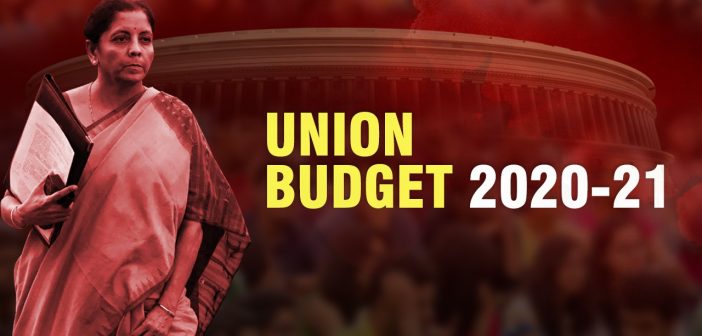Track2Realty Uncensored
The Union Budget 2020-21 has yet again been pretty disappointing for the Indian real estate. At a time when the survival of the sector has been at stake and the built environment was expecting the Finance Minister to come up with big ideas for revival, the government could only offer a confused budget that neither promises survival nor revival.
Real estate does not work in an isolation from the rest of the economy; it is a cog (an important cog) in the wheel of the economic cycle. The Union Budget 2020-21 has, however, viewed this sector as a separate engine of economic growth. And hence, while it fails to address the pain points of the sector, some of the lofty infrastructure & logistics announcements too failed to cheer the mood of the market.
In a balanced view, let’s accept that the Union Finance Minister Nirmala Sitharaman had limited options in a challenging macro-economic scenario where the focus has been to improve the market sentiments than addressing the critical areas that is derailing the economic growth.
With the subdued industry reactions, stock market downwards movement, and the home buyers’ disapproval, it seems the government has not done well on its part to even manage the headlines this time. After all, the budget neither promises to address the constraints of buyer nor seller in a marketplace called real estate.
However, the problem lies with the fact that the government thinks there is a buyer in the real estate market who does not need to be incentivized much. But there is no buyer today and what better testimony of the ground reality than the fact that even the affordable housing below the defined budget of INR 45 lakh in the top cities has no takers. Forget under construction, there are 3.87 lakh unsold ready to move housing units in the top 9 cities.
The Union Budget 2020-21 could at best be called an act of misleading tweaking. In the process, the budget stands neither here nor there. The idea was to have at least ‘One Big Idea’ that could invite the interests of investors in the sector. However, the focus has been so much on the larger demands of respective industries at the micro level that a comprehensive macro level picture was conveniently ignored.
For the real estate, it seems the government message is that if you wish to revive than learn to survive on your own. Unfortunately, in a market loaded with housing inventory, added with the liquidity crunch, the over-supply could only be absorbed with the revival in demand. There has been no announcement as to how the government would ease the stuck up projects after its initial stressed funds.
Missing the big idea
No restructuring of loans like 2008-09
Industry status after the policy reforms
No roadmap for rental housing
Infrastructure spending is thinly spread
No blueprint for strong contract enforcement
WTO compliant smart subsidy package for manufacturing missing
Tax deductions neutralized with curtailed exemptions
No incentive for under construction home purchase
Today, the industry is plagued with the liquidity crisis. Neither the buyer nor the lender is betting on the sector and the liquidity crisis could have been addressed with one-time restructuring of the loans, as was successfully done in 2008-09. The success of all the policy reforms hinges on the government’s own assessment of its approval first. And if the government thinks that the sector has been cleaned up to some extent, then the budget should have made a bold announcement to accord industry status to the sector; something that would have changed the market sentiments and also eased the liquidity crisis.
Moreover, while the Model Tenancy Act announced in the last budget is still work in progress, the Union Budget 2020-21 does not roll out a roadmap for encouraging the rental housing. Needless to add, the capital appreciation, or the lack of it, can’t compensate for the rental losses that keeps an investor away from a segment that could not only revive the demand but also fulfill the ambitious dream of ‘Housing for All’.
What could have actually reignited the demand was some structural reforms aimed at mid to long term job growth. The employment is today key to the economic revival and the revival of the real estate is no exception. Today, when the industrial warehousing is a silver lining in the gloomy realty environment and the investors are ready to bet on the long term growth story, focus should have been on the industrial warehousing and manufacturing that could take us closer to the dream project of ‘Make in India’.
Today, India is one of the least competitive market for manufacturing and there is no clarity as to how National Logistics Policy would change the realities of the most unorganized sector, forget about bringing the foreign investment.
The problem with the Union Budget is also that the infrastructure spending of the government is thinly spread today. Most of the projects are either delayed or waiting for funds. The much- hyped DMIC (Delhi Mumbai Industrial Corridor) is delayed and hence no sizeable foreign investment is expected to come in the manufacturing sector. The GIFT City has also not taken off, as projected to its potential. The need of the hour was to address in budget as to how WTO compliant smart subsidy package for manufacturing units could make India globally competitive.
Therefore, announcement of INR 3000 crore allocation for skill development is lofty but without a concrete vision. Similarly, declaration to build 100 airports doesn’t come with how could it possibly be exploited better.
Home buyers, unfortunately, are always viewed by the respective governments as a set of beneficiaries who have already bought the house. This set of audience has to make a choice whether or not they wish to avail the exemptions now. In the absence of the job growth the real potential of the Indian housing market could only exist on paper. Even the fence sitting buyers would not be encouraged with the Union Budget 2020-21 as there is no incentive for under construction property purchase at a time when the residential market is heading towards de-growth and buyers ready to wait for projected correction or crash.
Ravi Sinha
@ravitrack2media
Track2Realty is an independent media group managed by a consortium of journalists. Starting as the first e-newspaper in the Indian real estate sector in 2011, the group has today evolved as a think-tank on the sector with specialized research reports and rating & ranking. We are editorially independent and free from commercial bias and/or influenced by investors or shareholders. Our editorial team has no clash of interest in practicing high quality journalism that is free, frank & fearless.
Subscribe our YouTube Channel @ https://bit.ly/2tDugGl





